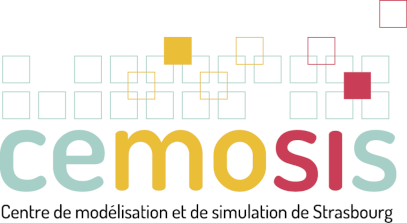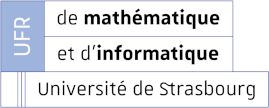Hygrothermal modeling and Simulation
First year internhip at the Centre de Modélisation et de simulation de Strasbourg

M1 CSMI

Supervized by
Vincent Chabannes, Zohra Djatouti, Romain Hild & Christophe Prud'homme
From June 8th 2020 to August 7th 2020
| The internship is a follow-up of a semester project. The report is available here. A quick summary of this report can be found on this page. |
Introduction
1. Context
According to the Intergovernmental Panel on Climate Change, the global warming of the planet is due to part because of human activities, and it is particularly due to high energy consumption. As we can see in figure 1, the sector that consumes the most is the building sector.

To face the challenge which is global warming, many measures have been taken, at different scales. In particular, since 2017, the Building Information Model has been used for new buildings.
The BIM, francized in bâti immobilier modélisé but which should be translated by Modélisation des Informations d’une Construction, is a working method and a 3D parametric model that contains intelligent and structured data. It is the sharing of reliable information throughout the life of a building, from its construction to its demolition.
In particular, BIM contains the 3D representation of a building and makes it possible to analyze, control, and simulate certain behaviors. The BIM is a data exchange medium and must, therefore, ensure numerical compatibility, regardless of the software used. Solutions have been put in place to integrate an equivalent of BIM into older buildings that did not have BIM at the time of their construction. One of the main sources of the energetic leak is due to moisture within the walls. Models have been created to simulate them to prevent such leaks.
The project 4fastsim-ibat, initiated in the Cemosis Laboratory deals with it. This project aims to develop a fast and efficient tool combining physical models, artificial intelligence, and in-situ measurements to identify potential energy-saving in existing buildings and to evaluate design and renovation solutions before they are implemented.
Many domains are involved in this project. For example, my colleagues Hanane and Sarra work on management of missing data in building thermics and Romain works on radiative heat transfert for their internship.
2. Cemosis
Cemosis, is the technological platform in mathematics at the University of Strasbourg, which links mathematics with business and other disciplines. It was created in January 2013 and is hosted by the IRMA (Institut de Recherche de Mathématique avancée), and is based on the Modelling and Control team.
The 4fastsim-ibat project is a collaboration between Cemosis and Synapse Concept, a company specialized in fluid and thermal simulation and virtual and augmented reality.
3. Objectives
During the second semester of the year, I made a project with Cemosis. This internship is the following. During this project, we studied the heat and moisture transport process and implemented an application allowing us to simulation this transport with Feel++. This application was designed to work on specific cases.
The main objective of this internship is to improve this program, allowing the user to configure it in many cases, and also to use is on more complex geometry. Another objective is to introduce quantities showing the comfort of occupants of a room and visualize them, to make improvements in conception and renovation of buildings.
4. Plan
The very beginning of the intership will consist in correcting the results that were not correct at the end of the project. Then we will study an other benchmark case, which involves only moisture transport process.
After that, we will improve the application feelpp_hm_heat_moisture that be began to developp during the project, by adding the possibility to configure the cases with JSON files. We will also add a feature that allows to calculate the heat and moisture transfer in a building, within the walls and the room.
Then, we will study thermal comfort in building and try to add this feature to our application.
Finally, for the end of the internship, we will study another mean to solve the equation, using the Hybrid Discontinue Galerkin method. We will focus on the heat equation from the coupled wall-room model, got from the Bestest benchmark.
5. Technical details
The codes of the application can be found on the GitHub repository.
At the end of the internship, all the application didn’t work.
-
The application
feelpp_hm_heat_moisturesimulating heat and moisture only in a porous wall did work. The code of this app is merged in themasterbranch and can be found at this state in history. The documentation of this application is on this page. -
The coupling between the room and the wall is not working yet (even if the code compiles). The code is in the branch
model, first used to develop the previous application. The name of this application isfelpp_hm_heat_moisture_2dorfeelpp_hm_heat_moisture_3d, depending in which dimension we are. At the end of the internship, the code was at this state in history. The documentation can be found here.
To build the application, go in the branch feature/quickstart of the repository feelpp (see the GitHub repository), then in the root of the cloned folder write :
cd feelpp/research && ln -s ../../hygrothermie
The folder feelpp and hygrothermie have to be in the same parent folder.
|
Then, in Visual Studio Code, build the target feelpp_hm_heat_moisture (or feelpp_hm_heat_moisture_[2d|3d] for the coupling application).
Once the target is built, go to the build folder and type
ninja hygrothermy_add_testcase_cases
to add the files used for the simulation (geo, JSON and cfg), present in the folder src/cases.
7. Acknowledgment
As this internship is the following of the project made during the second semester, I would like to thank the team of Cemosis who accepted to take me for this two-months internship. Even if it was in teleworking and during the summer holidays, my tutors were available to answer my questions and guide me in the work.
Especially, I thank :
-
Zohra Djatouti for the physicals details she gave me because my knowledge in that domain is quite limited !
-
Romain Hild for the technical details he gave me for the usage of Feel++ functions that were hard to handle,
-
Christophe Prud’homme for his disponibility to answer my question (even on a highway !), and for the skeleton of code he made.
Even if at the end, all the programs didn’t work well, I find the internship very interesting and instructive, even if some points were hard to apprehend, such as HDG formulation.